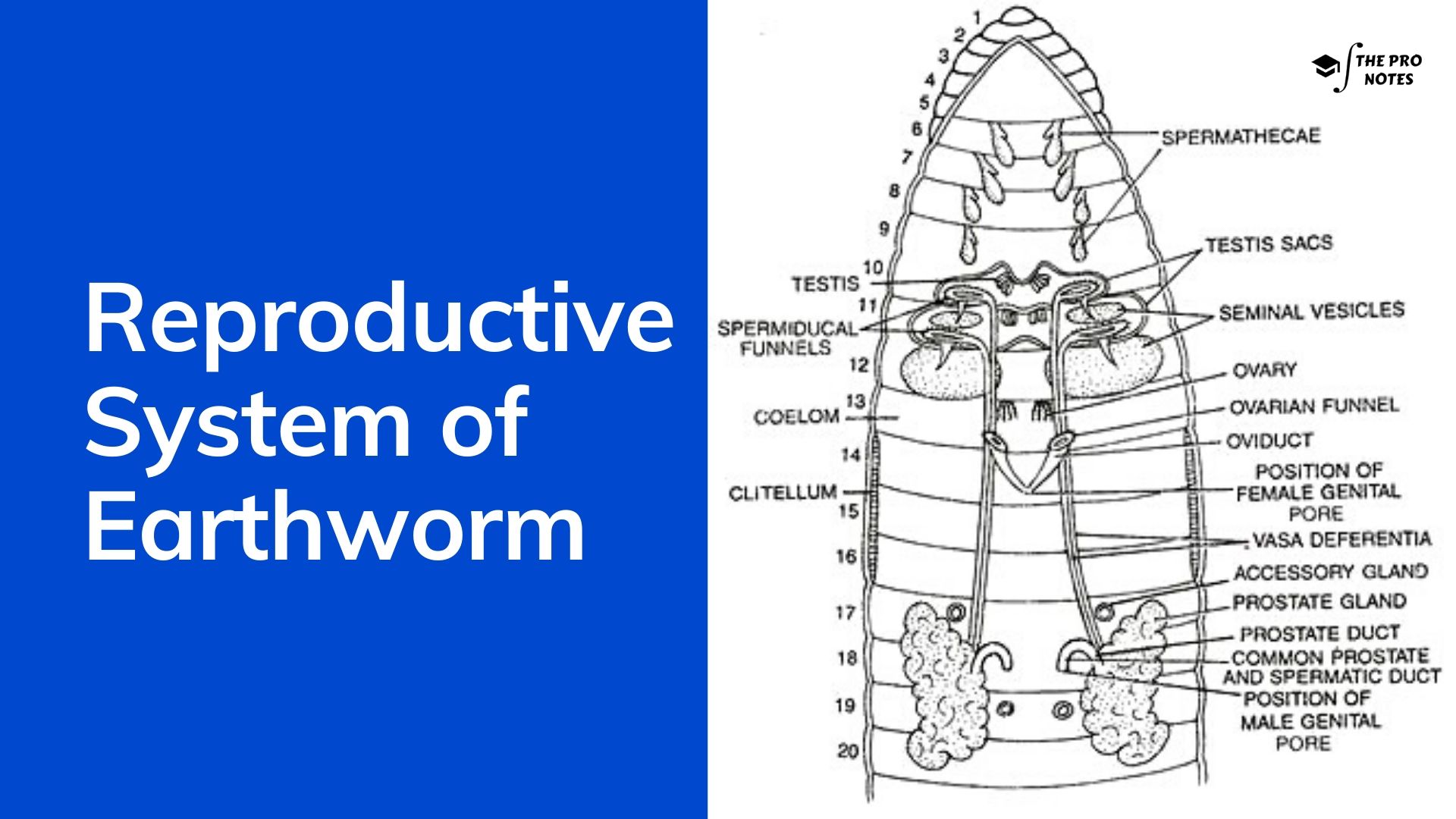This note is adapted from Reena Lamsal’s note from NHC.
Earthworms are hermaphrodite animals that mean a body of earthworm consists of both male and female organs.

Contents
Male reproductive System of Earthworm.
Earthworm’s male reproductive system consists of two pairs of the testis, two pairs of spermiducal funnel, two pairs of seminal vesicles, two pairs of vasdefence, one pair of prostatic gland and one pair of the common prosthetic prostatic spermatic duct and one pair of male genital aperture.
Testes
(The singular form is Testis and the plural form is Testes)
Two pairs of testes are found in the intersegmental groove of the 10th and 11th segments. Testes are 8-1- tubular structures containing sperm mother cells. These cells undergo meiotic division to produce sperms that are in an immature condition called Testisacs.
Testes Sacs
Testes sacs are the thin membranous structure that covers the two pairs of testes and two pair of seminal vesicles which is present in the 11th segment.
Spermatogonia
These spermatogonia are shed into the testes sac and enter into the seminal vesicles.
Seminal Vesicle
Two pairs of the seminal vesicle are found in the 11th and 12th segments on either side below each testis. Seminal vesicles contain nutritious secretion which helps to nourish the sperm.
Spermiduccal Funnel
Two pairs of Spermiduccal Funnel are found just below testis on either side in the same segment (10th and 11th). Spermiduccal Funnel receives matured sperm and passes it down to vas deference.
Vas Deference
Two pairs of Vas Differencia arise from each Spermiduccal Funnel which runs downwardly on either side and enters into the prostatic gland in the 18th segment.
Prostate Gland
These are irregular, flat, whitish bodies extending from 16th to 20th segments. Prostatic glands secrete alkaline secretion. It receives vas differencium and the sperm from Spermiduccal Funnel. The total content of the prostatic gland plus spermatic fluid is discharged through a common duct.
Common Prostatic Spermatic Duct
These are one pair of duct arising from the prostatic gland which opens into the male genital aperture in the 18th segment. Through this duct the male gamete along with prostatic secretion discharge out.
Male Genital Aperture
Male Genital Apperture is two openings in the ventral side in the 18th segment. Through these openings, spermatic fluid is discharged.
Female reproductive system of Earthworm.
The female Reproductive System of earthworm consists of one pair of the ovary, one pair of oviducal funnel, one pair of oviduct and single female genital aperture and four pairs of spermathecae.
Ovary
One pair of the ovary is situated in the intersegmental groove of the 13th segment. Ovaries are fan-like structures made up of 8-10 lobules, arranged column-wise. The base of the ovaries are narrow but the posterior part is expanded. Each lobule contains, ovum producing mother cell at the base which undergoes meiotic division to form the ovum. During development and maturation size of the ovum increases and finally, these ova shed (come) by rupturing the ovarian membrane.
Oviduccal Funnel
These are folded fimbriated, finger-like structure which catches the ova which are shed from respective sides of ovaries. The oviductal funnel has a central opening that opens into the oviduct.
Oviduct
These are tube-like structures with ciliated inner lining. These tubes carry ova from the oviductal funnel to the female genital aperture.
Female genital aperture
It is the single opening situated mid ventrally in the 14th segment. Through these opening ova are discharged into the clitellum.
Copulation In Earthworm
In earthworm, copulation takes place in the month of September-October at late night or early in the morning.
During copulation two worms come closer and lie through their ventral side keeping their head in the opposite directions. They attach to each other with the help of the secretion of genital papilla found in the 17th and 19th segments in such a way that male genital aperture comes to lie just over the spermatheca present in the 8th-9th segment.
With the help of a spermatic duct, spermatic fluid is poured into the spermatheca. When the two worms separate, the spermatic ducts fill the other pair of spermatheca which are situated in the 7th-8th, 6th-7th, 5th-6th segments.
Copulation takes for 24 hours. during copulation mutual exchange of spermatic fluid takes place between two worms.
Cocoon Formation In Earthworm
After copulation female reproductive organs develop and start the formation of ova. Ova are discharged in the clitellar region through the female genital aperture. The clitellum becomes a more glandular, thicker and band-like structure which is tough but elastic in nature. The albuminous secretion provides nourishment over the clitellum due to which a transparent tube-like structure develops.
Finally, the clitellum is shifted out over the head region by the dragging of the animal backwards. On the way, the clitellum receives spermatic fluid when it passes over the spermatheca. Citellum comes out of the body completely. The two openings are closed and it is called a cocoon, which is very small in size about 2mm and pale yellow in colour. Inside the cocoon, each sperm fertilizes each ovum so the fertilization is external.
Anyone fertilized ovum develops whereas the other degenerates. After some time young earthworm comes out of the cocoon by rupturing its wall.







